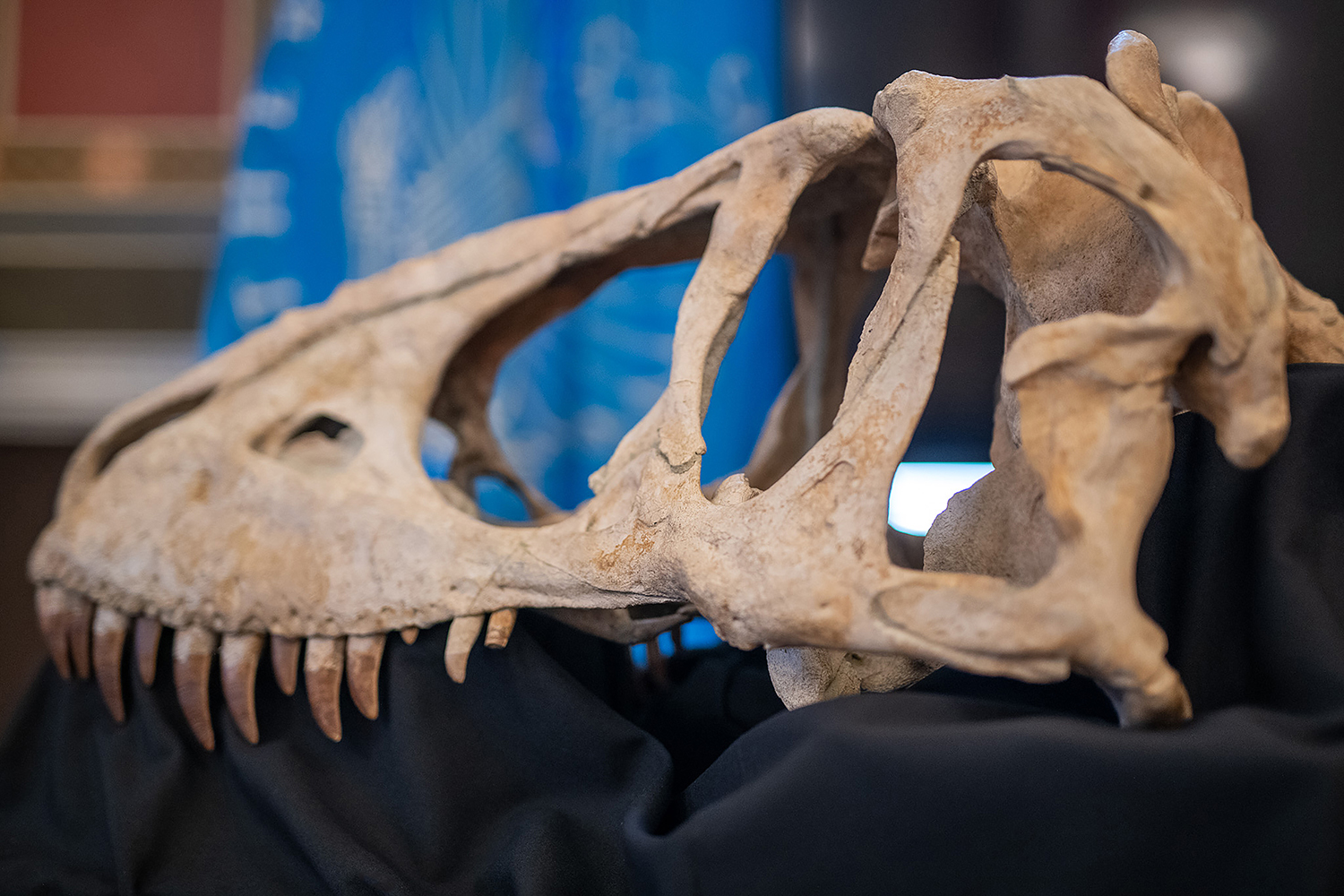Archived Content
In an effort to keep ICE.gov current, the archive contains content from a previous administration or is otherwise outdated. This information is archived and not reflective of current practice.
HSI repatriates high-profile dinosaur fossils to Mongolia
WASHINGTON — Homeland Security Investigations (HSI) returned an impressive collection of dinosaur fossils to Mongolia’s Ambassador to the United States, Batbayar Ulziidelger, at a ceremony at the Library of Congress on Aug. 3. The fossils were recovered through HSI investigations conducted by our offices in Arizona, New York, and Wyoming, and the collection was represented by a tyrannosaurus bataar skull, protoceratops fossil, alioramus skull, and saurolophus skull.
The alioramus, which resembles a smaller version of a tyrannosaurus rex, is exclusively found in Mongolia – the source of many, extremely rare fossils. The specimen on display at the ceremony is considered one of the best-preserved fossils ever found of the dinosaur that lived approximately 70 million years ago.
“Federal criminal and civil laws provide HSI the unique authority to take a leading role in investigating crimes involving the illicit importation, exportation, and distribution of cultural property, antiquities, and art – including fossils – which are part of a country’s cultural heritage and history,” said Executive Associate Director of HSI Katrina W. Berger. “Today’s repatriation includes specimens from 12 different investigations. I commend the case agents, partners, and experts whose hard work and dedication helped make this repatriation possible. These cases can be quite complex and take many years, but the reward is being able to return these objects to their rightful owners—the people of Mongolia.”
“Today’s event is dedicated to acknowledge the solid contributions of the officers and special agents from Homeland Security Investigations, U.S. attorneys, judges, scientists, and all individuals present here at ceremony as well as those who are absent due to their duty, who made this day possible,” said Ambassador of Mongolia Batbayar Ulziidelger. “This ceremony is a testament to the strong partnership between the Government of Mongolia and the Unites States and we are fortunate to witness the first-ever public display of these Mongolian dinosaur fossils.”
“We have gathered here to witness the return of dinosaur fossils from the United States to their homeland – Mongolia; these fossils, once lost to time and distance, now find their way back to the land, where they were first discovered,” said Minister for Foreign Affairs of Mongolia Battsetseg Batmunkh. “The remarkable journey of these artifacts demonstrates the strength of collaborative diplomacy and a solid dedication to preserving our cultural heritage. I am delighted to acknowledge the valuable contributions of law enforcement officers and special agents, agencies, attorneys, judges… our collective efforts demonstrated the potential to effectively fight illegal smuggling, both bilaterally and multilaterally.”
The first of these cases began in May 2012 when HSI New York initiated a cultural property investigation after receiving information alleging the illicit sale of protected fossils by a U.S.-based auction house. The investigation revealed that an individual, who later pled guilty to criminal counts of illegal importation of dinosaur fossils, was selling a fossilized alioramus skull through the auction house; that skull is part of the collection being returned.
That same year, HSI Casper, Wyoming office received an HSI Tip Line report that a retail store was selling a fossilized tyrannosaurus bataar skull. HSI Casper began its investigation relating to the illegal importation and subsequent sale of dinosaur fossils originating from Mongolia, which has strong patrimony laws that prohibit the export of prehistoric fossils.
These investigations led to multiple seizures of a wide range of paleontological fossils illegally taken from their country, including: a rare juvenile tyrannosaurus battar skull; a fossilized gallimimus skeleton; a tarbosaurus bataar skeleton; nests of dinosaur eggs; a saber-toothed cat skull; a complete psittacosaurus skeleton; and a protoceratops skull. Some of these dinosaurs lived more than 100 million years ago in an area now known as the Gobi Desert.
In addition to the seizures, HSI has pursued and obtained convictions for violations of Title 18 U.S. Code §§ 371 and 545, Conspiracy to Smuggle Goods into the United States.
HSI’s cultural heritage investigations are not limited to illicit paleontological specimens. In fiscal year 2022, the HSI’s Cultural Property, Art and Antiquities Program oversaw repatriations of cultural property to more than 15 countries, including France, India, Iraq, Italy, and Mali.
Since 2007, HSI investigations have led to the repatriation of over 20,000 objects to more than 40 countries and institutions. The repatriated objects have included Nazi-looted art, French paintings, Egyptian sarcophagi, Italian sculpture, Roman coins, Greek vases, illuminated manuscripts, and even human remains.
Follow us on X, formerly known as Twitter, @HSI_HQ to learn more about HSI’s global missions and operations.







